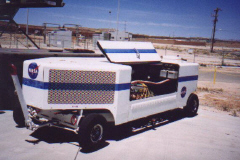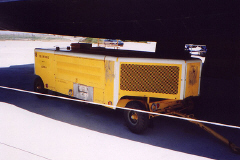Starter Cart

NASA (Chevy) Starter Cart
Unlike conventional aircraft, all variants of the Blackbird used a very unique starting system that consisted of a drive shaft that was vertically inserted through the underneath each of the nacelles to the engines. This shaft would spin, thus turning the turbines inside the J58 and starting the aircraft. However, it was not by this simple system alone that the Blackbird was started. The Blackbird also required a shot of TEB or Triethylborane, a catalyst that ignited the fuel. This process was a coordinated effort between the aircrew and the "buddy" crew, those who helped prepare the aircraft for flight.

Buick Starter Cart at Blackbird Airpark
The starter carts were in two different variants: the Buick and Chevy carts. In the early days, the Buick-based carts were used. These units were yellow and had twin Buick V-8 engines in them. However, later in the program, these engines were replaced with big-block Chevy engines, thus deriving the Chevy starter cart. The engines in the carts are accessible through opening hoods on the sides of the cart. The exhaust for the engines is routed through an exhaust pipe on the side of the cart (noticeable in the upper right image of the NASA cart). The two engines are connected via drive belts.
Both starter carts are of the same dimensions although they are distinguishable. Even though the Buick carts are commonly yellow, the Chevy carts have been in a variety of colors: standard olive drab (dull, dark green), black, and NASA's stylish white with the blue stripe.
There were also other methods of starting the aircraft, two of these were developed for the proposed F-12B program. The Air Force had a requirement that in order for the F-12B to be successful as an interceptor, it would need to be started without delay for a quick launch. This starting system consisted of an attachable unit under the nacelle like any other starter cart, but there was a chemical process that took place in adjacent starting cartridges. This reaction allowed for the spinning of the vertical drive shaft, thus starting the engine. In addition, another process was developed which was turbine-powered. However, these systems proved impractical for the SR-71 and were not used considerably.
Eventually, these carts were phased out when permanent starting systems were installed in the Beale AFB hangars. This system consisted of compressed air tanks of considerable size that were used to rotate an attached unit. However, the portable carts were still servicing SR-71s at distant operating locations. Nevertheless, when NASA took over a few SR-71s at Edwards AFB, the starter carts were once again used because the aircraft was started and checked before flight out on the ramp.
It is not known how many of these carts were built, nor how many exist today. Little information is released on this subject simply because it is not a prime area of interest. These carts are on display in various museums around the country. It is also rumored that some are in storage at key facilities like AMARC (Davis Monthan AFB), and Wright Patterson AFB, OH. Before you leave, be sure to view more images of the starter carts at the image gallery.